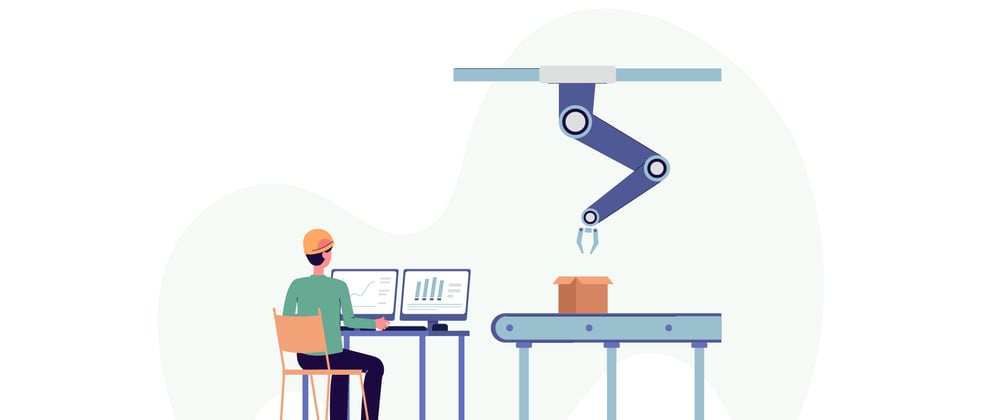Internet of Things (IoT) has become one of the most emerging technologies that boost the manufacturing industry. It defines the network of physical objects integrated with sensors, apps, and other technology in order to communicate and share data over the Internet with other systems.
The Industrial Internet of Things (IIoT) represents the usage of the Internet of Things in industrial industries and applications. By leveraging machine-to-machine (M2M) connectivity, big data, and machine learning, IIoT allows industries to achieve greater performance and quality in their production processes.
Manufacturers are turning to the IIoT as it represents a powerful weapon in their attempts to scale more efficiently. This transition is motivated by the need for companies to use emerging technology to strategically produce positive results.
Initially, IIoT offers many ways to improve the functionality of simple production processes. However, there’s much more than that. The advantages of IIoT include generating efficiencies in the supply chain to designing technologies and models that can contribute to sales growth. This potential for development comes from the ability to identify activities in actual product use and leverage them in the production process to add more value.
For example, digital products can collect data that the manufacturer can use to further optimize the product. What is more, they can use these insights to identify new business opportunities.
The Challenges of Industrial IoT
DevOps is at the center of the market disruption. With DevOps, enterprises get the ability to create the requisite flexible and automated infrastructure that has the capacity to process vast numbers of actions and drive data insights.
Building software products requires different processes than building hardware products. Challenges are also different:
- Create an embedded software that will manage your devices
- Increase the margin to reduce expensive bug fixes for robust products
- Enrich existing products with new features more rapidly or introduce new, revolutionary products
- Enable software scaling with automated deployments
- Synchronize firmware and software updates
- Implement security and alarming standards to prevent data leakages
- Provide storage for the collected data from all devices in real-time
DevOps for Industrial IoT focuses on developing apps to make the data useful. Furthermore, it enables developers to move and iterate rapidly, delivering changes in real-time.
Why DevOps for Industrial IoT?
By combining development and operations, DevOps can bring many benefits to manufacturers and optimize a lot of processes. This is supported by the DevOps culture, a set of methods that improve the efficiency and scalability of production.
What Are the Advantages of DevOps for Industrial IoT?
- Increased frequency of deployments
- Increased code and app quality
- Faster time-to-market for new features
- Minimized chances for release failures
- Faster recovery after failures
For example, when several IoT-enabled devices are placed in different manufacturing venues to track energy data, these devices have to track every event that includes energy spending. This includes turning machines on, increasing their levels, etc. In order to catch these activities as they happen during the workday, a DevOps-enabled infrastructure will automatically scale up, and then scale down after the end of the workday to minimize running costs.
Michael Rowe, an IBM researcher, wrote an article for TechBeacon where he mentions car-sharing service car2go and aviation engine supplier Power by the hour as industry examples that create value supported by the software they contain. According to him, customers no longer value the physical engineering and the design of sheet metal the most. Instead, the user experience could be significantly improved by software that monitors the fuel mixture or the handling characteristics. When looking at the vehicle, neither the algorithms nor the embedded code that determines that experience are evident.
How Does DevOps Enhance IoT?
To succeed in DevOps, companies need to take a systematic approach. This means that the transformation of the entire organization needs to take place. Operations and development teams, quality assurance testing, and all other sectors that participate in the making of an app, including managers and business owners. These are some of the ways DevOps for Industrial IoT boosts the entire company performance:
Better Communication and Collaboration
Increased teamwork and interaction around the organization is one of the top benefits of DevOps. A greater alignment between quality assurance, operations, and production teams follows a strategy in which all of them partner with the customer to create a tailored solution that satisfies their expectations and demands.
More Effective Testing
The role of the production environment can be validated by application testing. The DevOps teams will then find dependencies, obtain insight into the functionality of the application, and make changes accordingly. With automation and implementation, these procedures become routine, allowing for further rollout, testing, and growth.
Measuring Analytics and Performance
By pushing the research forward in the process, analytics and success tracking arrive early in the life cycle. Instead of waiting to collect post-production output data to analyze what went wrong, DevOps implements specific analytics models that can forecast quality and organizational issues before rollout.
This data can help you set up KPIs and measure them more easily. When output parameters stick more closely to the key performance measures, you can increase the overall performance and improve customer experience.
Automation
Through the automation of processes, manufacturers gain the ability to scale solutions while reducing complexity and costs. DevOps should take care of the IoT software by considering the operational aspects, as well as ensuring maximum efficiency of the devices by positioning them correctly.
Here’s how DevOps automates processes:
CI/CD
Continuous integration and continuous development provide a streamlined and automated development process. This speeds up deployment through Build, Test, Integrate, Deploy, and other automated production pipelines. Continuous integration also contributes to better agility and communication.
Containers
IIoT solutions that don’t rely on a serverless architecture incorporate a virtualized layer with a container architecture and an orchestration manager. This model is based on one or more containers running on virtual machines, developed with microservices. This is a strategy that teams should use when they are planning to add many new features and scale.
Usually, containers have several microservices that converge to construct the functioning of the entire software. They involve all necessities like libraries that are needed to enable the software to run on various platforms. This reduces the complexity of deployment in different platforms as the application scales.
Container Orchestration
As the application scales, so does the container architecture. This makes container management difficult. Kubernetes is the most popular container orchestration tool that defines the desired state of the system, supporting it with an orchestration control function. Kubernetes enables automated recovery from failure, decreased scaling complexity, and higher security. (For some Kubernetes users, things Other tools that further support orchestration include OpenShift, DockerSwarm, or Amazon’s EKS.
Embracing the DevOps Culture
DevOps is not only about the toolchain. One of the first obstacles to address is the company culture, regardless of whether DevOps is generated as a new entity or combined from current development and operations processes. The modified culture must rely on the opportunity to deliver solutions that are quicker and more efficient and that can keep up with the demands of the market.
In the center of the DevOps culture are agile methodologies, which rely on autonomy and speed. However, not all teams have the required expertise to support this autonomy. That’s why the culture doesn’t always have to be limited and to include engineers only. A real DevOps strategy entails the collaboration between development, operations, company owners, clients, and partners. Together, they need to enable the company to develop and release fast and quality solutions that achieve business goals.
In the Industrial IoT sector, in particular, DevOps can provide faster feedback, allowing the team to improve performance. Based on the data collected about device use, production teams can come up with activities that will optimize device use. These activities can include improved maintenance by identifying pain points based on real-life use, automating parameters that optimize energy consumption, and an overall improvement of the behavior of all connected devices.
The culture shift should result in improved customer engagement, as the connected devices will be optimized according to the needs of each customer.
Conclusion
The customer-driven “on-demand” mentality of today now allows companies to follow an agile methodology that is a core tenet of DevOps for continuous development and delivery. And, as companies continue to integrate technologies with the strategic digital priorities of their clients, Industrial IoT will be a critical component to growth. The industry will start to see DevOps as a critical pillar of IIoT, providing a better understanding of how to build and implement applications in order to simplify IoT devices.







Latest comments (0)